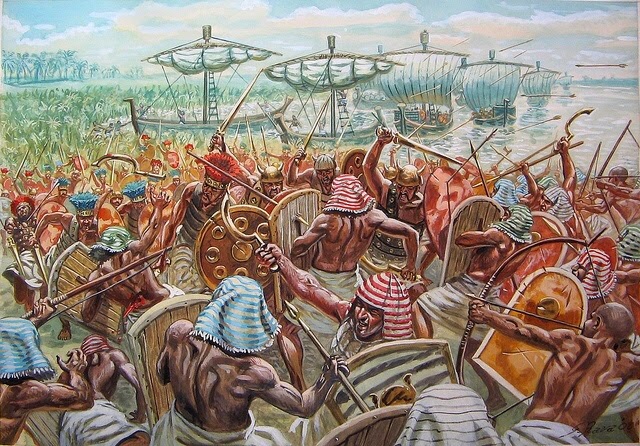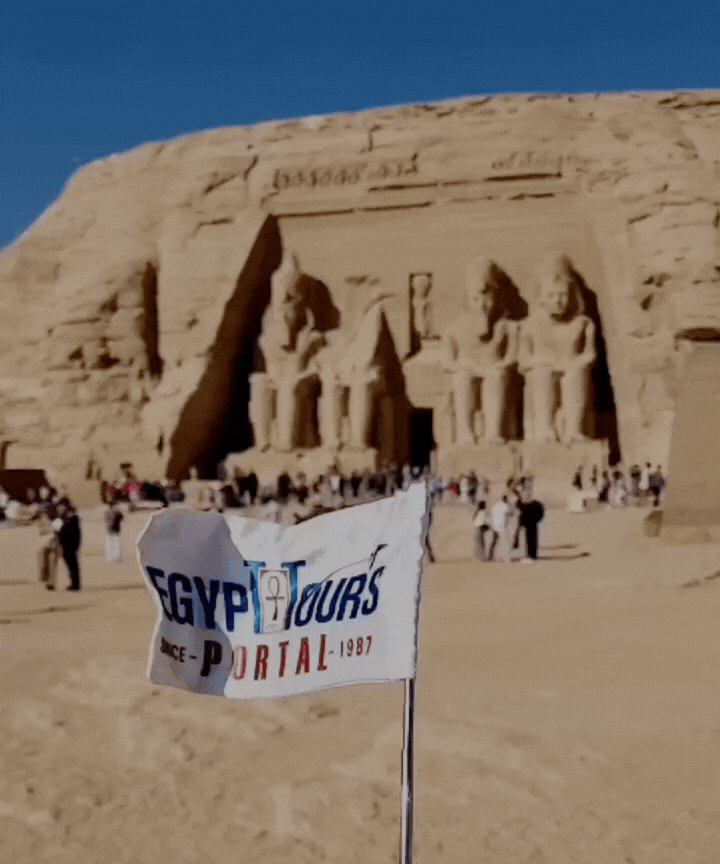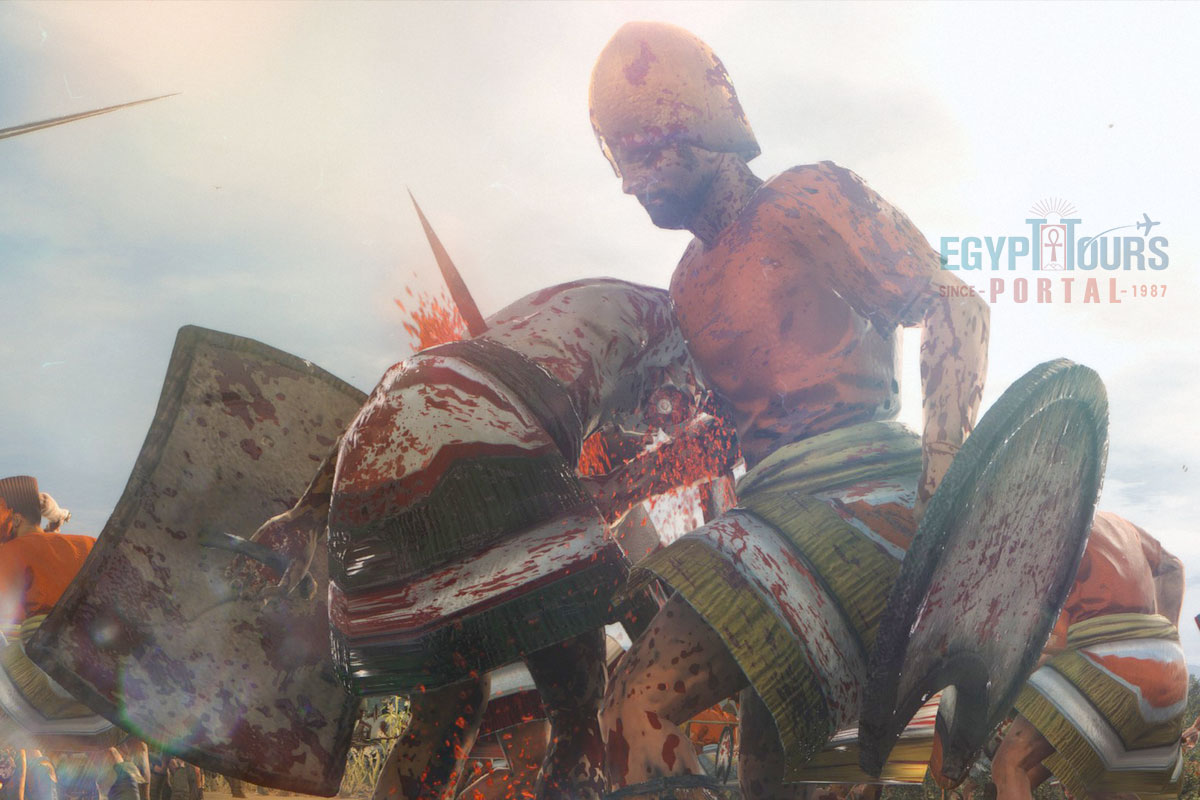The Battle of Djahy, fought in 1178 BCE, saw Pharaoh Ramesses III achieve a decisive victory against the Sea Peoples, halting their invasion of Egypt. Utilizing both land and naval forces, Ramesses III’s strategic use of chariots and tactical brilliance secured Egypt’s borders. Though the victory solidified his legacy, the battle strained Egypt’s economy and military, marking the beginning of the New Kingdom’s decline. The battle’s significance is immortalized in the inscriptions at Medinet Habu.


The Battle of Djahy was fought in 1178 B.C. along Egypt’s eastern frontier, marking a pivotal moment in ancient Egyptian history, showcasing the resilience and strategic brilliance of Pharaoh Ramesses III against the formidable Sea Peoples. This confederation of foreign warriors had ravaged the eastern Mediterranean, toppling powerful empires and threatening Egypt’s prosperity.
In response, Ramesses III prepared a strong defense, ultimately leading his forces to victory in one of his greatest military achievements. Depicted in the temple of Medinet Habu, the battle serves as a lasting testament to Egypt’s might and the Pharaoh’s commitment to protect his kingdom, reflecting the turbulent era of the Late Bronze Age, when migration and conflict reshaped civilizations.

Throughout ancient Egyptian history, the Sea Peoples were a confederation of seafaring warriors whose origins remain shrouded in mystery, posing an intermittent threat to Egypt’s stability. Although they had attempted to invade Egypt during the reigns of Pharaoh Ramesses II and his successor Merenptah, they were thwarted each time, largely due to their lack of coordinated strength and Egypt’s formidable military defenses.
However, under the reign of Ramesses III, the Sea Peoples emerged as a more organized and aggressive force, threatening the very future of Egypt’s security and prosperity. In response, Ramesses III, perceiving their threat as more dire than ever before, initiated a major defense strategy that would culminate in the pivotal Battle of Djahy.
This battle, which unfolded in 1178 B.C., took place in the coastal city of Djahy (modern-day southern Lebanon) and marked one of the Egyptian Empire’s most significant engagements against foreign invaders. The conflict brought together Egypt’s land and naval forces under the command of Ramesses III to face off against the ferocious Sea Peoples in a struggle for the survival of Egypt’s borders.

The Sea Peoples were characterized as raiders and warriors of remarkable skill and ambition, who roamed the eastern Mediterranean, plundering and destabilizing many of the region's established powers. Their relentless campaigns led to the destruction of major civilizations, including the Hittite Empire, the Mycenaean civilization, and the Mitanni kingdom.
Skilled in military organization and highly strategic in their invasions, they exhibited ferocity and sophistication in their attacks that were etched in the walls of Ramesses III’s mortuary temple at Medinet Habu. Driven by a desire to expand their influence and obtain control over fertile, resource-rich lands, they ultimately set their sights on Egypt, drawn by its lush farmlands, precious metals, and abundant resources like gold and gemstones.
The Sea Peoples’ conquests had left devastation in their wake, weakening Egypt’s neighboring powers and leaving the Egyptian Empire isolated against an alliance of highly organized and determined invaders.

Following their sack of Kadesh, a strategic city along the Levant, the Sea Peoples moved towards Egypt’s borders, intent on further conquest. Ramesses III, foreseeing their advance, fortified his armies and prepared defensive measures along Egypt’s eastern frontier. When the Sea Peoples’ land forces reached the Egyptian border at Djahy, they were met by Ramesses III’s well-prepared military.
A fierce battle ensued, with the Egyptians prevailing in a decisive land victory. Despite this triumph, the Sea Peoples were not deterred. They regrouped and launched an attack by sea, deploying a formidable naval fleet. Their ships, superior in design and manned by expert sailors, initially posed a severe threat to the Egyptian naval forces, who were less experienced and had less advanced ships.
Ramesses III, however, employed a brilliant tactical maneuver that would secure Egypt’s naval supremacy in the ensuing Battle of the Delta. Anticipating the enemy’s course along the Nile Delta, he allowed their fleet to advance into the Nile River. With their combined use of oars and sails, Egyptian ships were far more maneuverable in the river’s narrow channels, giving them a tactical edge.
Egyptian bowmen stationed on both the ships and along the riverbanks used grappling hooks to disrupt and capsize the Sea Peoples’ vessels. As the battle raged, Egyptian archers unleashed a deadly barrage of arrows upon the Sea Peoples, whose limited armament, swords, and spears proved ineffective in the face of Egypt’s defensive tactics. The strategic use of grappling hooks and archery turned the tide of battle, culminating in another decisive Egyptian victory.

The Battle of Djahy took place along Egypt’s eastern frontier, specifically in Djahy, an area located in what is today southern Lebanon. This region was part of the Levant, a strategically significant area connecting Egypt to key trade routes and neighboring territories. Djahy’s geographic position made it a critical buffer zone for Egypt against incoming invasions, particularly from the north and northeast, where the Sea Peoples’ confederation was actively raiding and plundering.
Djahy itself was a coastal region with access to both land and sea routes, making it an ideal location for the Sea Peoples to initiate their assault on Egypt. The terrain of the Levantine coast, with its rocky cliffs, narrow inlets, and coastal plains, posed both challenges and advantages. These natural features allowed the Egyptian army to monitor enemy movements from the coastline while preparing defensive formations inland. The geographic conditions of Djahy enabled Ramesses III to leverage his forces effectively against both the land and naval forces of the Sea Peoples, ensuring a multi-front defense that played a key role in Egypt’s victory.

The primary historical account of the Battle of Djahy comes from the inscriptions at the mortuary temple of Ramesses III in Medinet Habu. These hieroglyphic texts offer one of the longest and most detailed records of a military campaign from ancient Egypt, vividly describing the confrontation with the Sea Peoples. The inscriptions depict Ramesses III as a powerful defender of Egypt, highlighting his role in safeguarding the nation from invaders who had devastated other civilizations across the Mediterranean Sea.
The temple walls not only recount the tactics and outcome of the battle but also illustrate the identity and appearance of the Sea Peoples. These texts describe the Sea Peoples’ confederation, listing groups such as the Peleset, Tjeker, Shekelesh, Denyen, and Weshesh. The Medinet Habu reliefs portray the battle scenes with intricate depictions of bound prisoners, Egyptian chariots, and enemy warriors, capturing both the scale and intensity of the conflict. Through these ancient Egyptian texts and inscriptions, Ramesses III emphasizes the Egyptian victory as a triumph over foreign invaders, underscoring his divine right to rule and the strength of Egypt’s military forces.
Explore the different enemies of the ancient Egyptian civilization
Read More
The strategy employed by Ramesses III in the Battle of Djahy showcased his tactical foresight and military prowess. Aware of the Sea Peoples’ advance through the Levant after they sacked nearby territories, Ramesses III preemptively fortified Egypt’s borders. He positioned his forces strategically along the eastern frontier, deploying both chariotry and infantry units. Ramesses III’s choice to engage the Sea Peoples in Djahy allowed him to intercept the invaders before they could penetrate deeper into Egyptian territory, effectively stopping them at a defensive line along the Levantine coast.
One of the most crucial aspects of Ramesses III’s strategy was his use of chariotry. The Egyptian chariots were light, swift, and highly maneuverable, allowing them to counter the Sea Peoples’ infantry in a way that maximized mobility and attack speed. Ramesses III’s forces also employed psychological tactics, bolstering the morale of his troops with ceremonial displays of the Pharaoh’s authority. Once victory was achieved on land, Ramesses III anticipated a naval attack and prepared a counterstrategy for the ensuing Battle of the Delta.
By trapping the Sea Peoples in the narrow channels of the Nile Delta, the Egyptian fleet, equipped with archers and maneuverable ships, was able to decimate the enemy’s naval forces, securing a comprehensive victory. This layered defense demonstrated Ramesses III’s understanding of both the geographic and tactical dimensions of warfare, establishing him as one of Egypt’s most formidable military leaders.
Discover the weapons of the ancient Egyptian army
Read More
Despite their remarkable victories, Egypt’s triumph over the Sea Peoples came at a significant cost. The extended conflict left the Egyptian military exhausted and depleted Egypt’s financial resources, severely straining the state treasury. The Battle of Djahy, followed by the intense naval engagement in the Delta, marked a turning point in Egyptian history.
While the Egyptian army successfully defended their homeland and thwarted the Sea Peoples’ invasion, the toll on Egypt’s economy and military capabilities signaled the beginning of a gradual decline in the New Kingdom’s power. The strain weakened Egypt’s defenses, leaving the empire vulnerable to future threats and eventually leading to the loss of its influence over Asia and Nubia. Less than a century later, during the reign of Ramesses XI, Egypt’s dominance had diminished significantly, marking the end of the New Kingdom.
The Battle of Djahy remains one of ancient Egypt’s most celebrated military achievements and a defining event in the broader history of the ancient world. It underscores the strength of Egypt’s leadership, army, and tactical ingenuity, as well as the resilience of a civilization that, at its height, contributed foundational advancements in science, governance, and culture that continue to impact the world today.
After having all information, I hope you enjoyed this article and you can discover Egypt’s glorious history, civilization, and culture during your Egypt tours and try our breathtaking nile river cruise to cast your eyes on the temples and tombs in Upper Egypt, So Don’t miss the chance to live the greatest adventure of your life.
Private 4 Days Cairo Tour Packages for American Travelers 4 days Cairo Egypt Tour pa...
Tour Location: Cairo – Giza...
5 Days Cairo and Alexandria Tour Package For American Travelers 5 days Cairo and Ale...
Tour Location: Cairo/Giza/Alexandria...
6 Days Cairo, Luxor & Aswan Tour Package For American Travelers 6 days Cairo, Lu...
Tour Location: Cairo/Giza/Aswan/Luxor...
Amazing 7 Days Cairo and Hurghada Holiday for American Travelers 7 Days Cairo & ...
Tour Location: Cairo – Giza – Hurgh...
The entire country of Egypt deserve to be explored with its every heavenly detail but there are places that must be seen before any other such as the breathtaking Hurghada's red sea, The wonders of Cairo the pyramids of Giza, the great sphinx, the Egyptian Museum, Khan El Khalili Bazaar, the wonders of Luxor like Valley of the Kings, Karnak & Hatshepsut temple and the wonders of Aswan such as Abu Simbel temples, Philea temple, Unfinished obelisk and The Wonders of Alexandria like Qaitbat Citadel, Pompey's Pillar and Alexandria Library. Read more about the best places to visit in Egypt.
If you want to apply for a Visa On Arrival that lasts for 30 days then you should be one of the eligible countries, have a valid passport with at least 6 months remaining and pay 25$ USD in cash, as for the E-Visa for 30 day you should have a valid passport for at least 8 months, complete the online application, pay the e-visa fee then print the e-visa to later be presented to the airport border guard. You could also be one of the lucky ones who can obtain a free visa for 90 days. Read more about Egypt travel visa.
Egypt has a variety of delicious cuisines but we recommend “Ful & Ta’meya (Fava Beans and Falafel)”, Mulukhiya, “Koshary”, a traditional Egyptian pasta dish, and Kebab & Kofta, the Egyptian traditional meat dish.
The best time to travel to Egypt is during the winter from September to April as the climate becomes a little tropical accompanied by a magical atmosphere of warm weather with a winter breeze. You will be notified in the week of your trip if the Climate is unsafe and if any changes have been made.
You should pack everything you could ever need in a small bag so you could move easily between your destinations.
We have been creating the finest vacations for more than 20 years around the most majestic destinations in Egypt. Our staff consists of the best operators, guides and drivers who dedicate all of their time & effort to make you have the perfect vacation. All of our tours are customized by Travel, Financial & Time consultants to fit your every possible need during your vacation. It doesn't go without saying that your safety and comfort are our main priority and all of our resources will be directed to provide the finest atmosphere until you return home.
You will feel safe in Egypt as the current atmosphere of the country is quite peaceful after the government took powerful measures like restructuring the entire tourist police to include all the important and tourist attractions in Egypt. Read more about is it safe to travel to Egypt.
Wear whatever feels right and comfortable. It is advised to wear something light and comfortable footwear like a closed-toe shoe to sustain the terrain of Egypt. Put on sun block during your time in Egypt in the summer to protect yourself from the sun.
The best activity is by far boarding a Nile Cruise between Luxor and Aswan or Vise Versa. Witness the beauty of Egypt from a hot balloon or a plane and try all the delicious Egyptian cuisines and drinks plus shopping in old Cairo. Explore the allure and wonders of the red sea in the magical city resorts of Egypt like Hurghada and many more by diving and snorkeling in the marine life or Hurghada. Behold the mesmerizing western desert by a safari trip under the heavenly Egyptian skies.
There are a lot of public holidays in Egypt too many to count either religious or nation, the most important festivals are the holy month of Ramadan which ends with Eid Al Fitr, Christmas and new years eve. Read more about festivals & publich holidays in Egypt.
Egypt is considered to be one of the most liberal Islamic countries but it has become a little bit conservative in the last couple of decades so it is advised to avoid showing your chest, shoulders or legs below the knees.
Arabic is the official language and Most Egyptians, who live in the cities, speak or understand English or at least some English words or phrases. Fewer Egyptians can speak French, Italian, Spanish, and German. Professional tour guides, who work in the tourism sector, are equipped to handle visitors who cannot speak Arabic and they will speak enough English and other languages to fulfill the needs of all our clients.
The fastest way is a car, of course, a taxi. If you are in Cairo ride a white taxi to move faster or you could board the fastest way of transportation in Egypt metro if the roads are in rush hour.
The temperature in Egypt ranges from 37c to 14 c. Summer in Egypt is somehow hot but sometimes it becomes cold at night and winter is cool and mild. The average of low temperatures vary from 9.5 °C in the wintertime to 23 °C in the summertime and the average high temperatures vary from 17 °C in the wintertime to 32 °C in the summertime. The temperature is moderate all along the coasts.
It is the home of everything a traveler might be looking for from amazing historical sites dating to more than 4000 years to enchanting city resorts & beaches. You will live the vacation you deserve as Egypt has everything you could possibly imagine.









